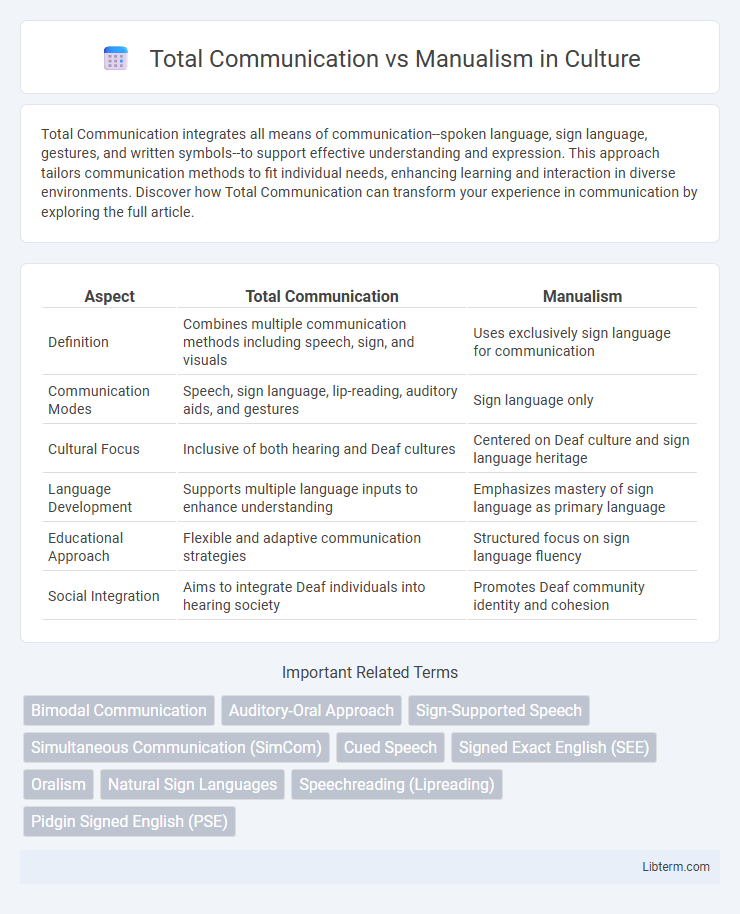Total Communication integrates all means of communication--spoken language, sign language, gestures, and written symbols--to support effective understanding and expression. This approach tailors communication methods to fit individual needs, enhancing learning and interaction in diverse environments. Discover how Total Communication can transform your experience in communication by exploring the full article.
Table of Comparison
| Aspect | Total Communication | Manualism |
|---|---|---|
| Definition | Combines multiple communication methods including speech, sign, and visuals | Uses exclusively sign language for communication |
| Communication Modes | Speech, sign language, lip-reading, auditory aids, and gestures | Sign language only |
| Cultural Focus | Inclusive of both hearing and Deaf cultures | Centered on Deaf culture and sign language heritage |
| Language Development | Supports multiple language inputs to enhance understanding | Emphasizes mastery of sign language as primary language |
| Educational Approach | Flexible and adaptive communication strategies | Structured focus on sign language fluency |
| Social Integration | Aims to integrate Deaf individuals into hearing society | Promotes Deaf community identity and cohesion |
Introduction to Communication Approaches in Deaf Education
Total Communication integrates spoken language, sign language, gestures, and visual aids to support deaf learners' comprehensive language development. Manualism emphasizes the use of sign language as the primary mode of communication, fostering natural language acquisition through visual-manual means. Both approaches prioritize access to effective communication tailored to individual needs in deaf education settings.
Defining Total Communication
Total Communication is an inclusive communication approach combining speech, sign language, gestures, lip reading, and auditory aids to support individuals with hearing impairments. Unlike Manualism, which relies solely on sign language for communication, Total Communication emphasizes the use of multiple methods tailored to each person's needs. This approach maximizes language access and enhances effective interaction across diverse communication abilities.
Understanding Manualism
Manualism emphasizes the exclusive use of sign language to develop communication skills, prioritizing natural language acquisition in deaf education. It fosters linguistic and cognitive development by focusing on visual-manual modalities, enabling direct and nuanced expression without reliance on spoken language. Understanding Manualism involves recognizing its role in preserving Deaf culture and enhancing Deaf identity through rich, embodied communication practices.
Historical Evolution of Communication Methods
Total Communication emerged in the 1960s as an inclusive educational approach integrating sign language, oral speech, lip reading, and gestures to support diverse communication needs. Manualism, rooted in the early 19th century, emphasized sign language as the primary mode of instruction for deaf individuals, notably influenced by the establishment of the American School for the Deaf in 1817. The historical evolution from Manualism to Total Communication reflects a significant shift towards multimodal strategies aimed at enhancing accessibility and language development in deaf education.
Key Differences: Total Communication vs Manualism
Total Communication employs a combination of methods including sign language, speech, lip reading, and written language to facilitate communication, whereas Manualism relies exclusively on sign language. Total Communication aims to maximize understanding by integrating multiple modalities tailored to the individual's needs, while Manualism emphasizes the use of manual signs as the primary mode of interaction. The key difference lies in Total Communication's multimodal approach compared to Manualism's singular focus on sign language.
Advantages of Total Communication
Total Communication maximizes language accessibility by combining speech, sign language, lip reading, gestures, and visual aids, ensuring communication is tailored to individual needs. It promotes inclusive learning environments by supporting multiple modes of communication, which enhances comprehension and social interaction for deaf or hard-of-hearing individuals. This approach adapts fluidly to varied communication preferences, fostering more effective language development compared to Manualism, which relies solely on sign language.
Strengths and Limitations of Manualism
Manualism, which emphasizes the exclusive use of sign language for communication, offers strengths such as fostering strong visual language skills and providing a natural, accessible mode of interaction for Deaf individuals. However, its limitations include potential challenges in integrating with spoken language environments and limited accessibility for those not proficient in sign language. This approach may also restrict communication opportunities in mainstream settings where oral communication predominates.
Impact on Language Development and Literacy
Total Communication integrates sign language, spoken language, and other communication methods to enhance language development and literacy, promoting greater flexibility and individualized learning. Manualism relies solely on sign language, providing strong visual language foundations but may limit exposure to spoken language components essential for some literacy skills. Research indicates that Total Communication often supports broader language acquisition and literacy outcomes by combining multiple modalities for diverse learners.
Parental and Educator Roles in Method Selection
Parental and educator roles are crucial in selecting between Total Communication and Manualism for deaf children, as their preferences directly impact language development outcomes. Parents often prioritize comprehensive inclusion of multiple communication modes, while educators may focus on consistency and language acquisition efficiency through Manualism's exclusive use of sign language. Collaboration between parents and educators ensures tailored communication strategies that align with the child's cognitive and social needs, optimizing language proficiency and academic success.
Current Trends and Future Perspectives in Deaf Education
Total Communication, integrating sign language, speech, lip reading, and residual hearing, remains prominent in deaf education for its inclusive approach fostering diverse communication skills. Manualism, emphasizing exclusive use of sign language, sees increased advocacy aligned with cultural identity and cognitive development benefits for Deaf individuals. Emerging trends prioritize personalized, technology-assisted methods, combining Total Communication's versatility with Manualism's cultural emphasis to enhance language acquisition and academic outcomes.
Total Communication Infographic

 libterm.com
libterm.com